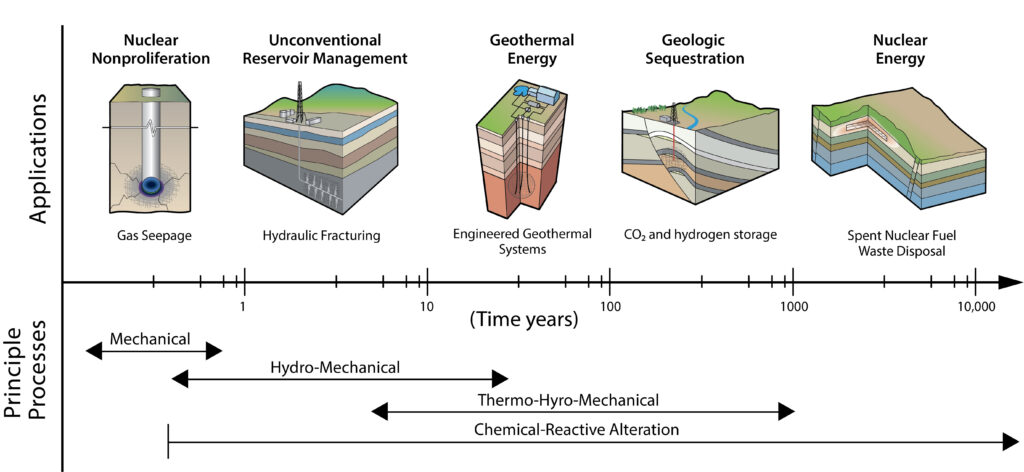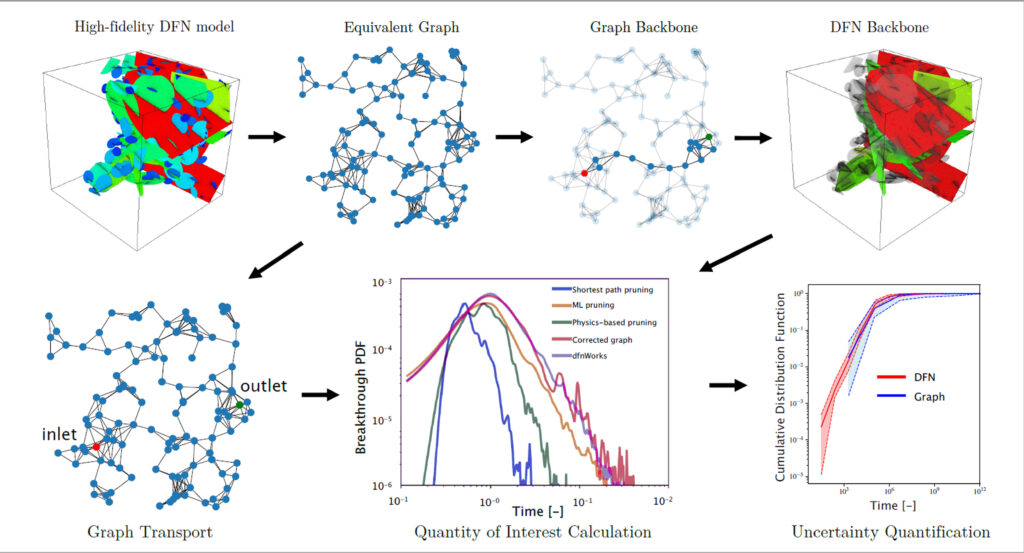Editors’ Vox is a blog from AGU’s Publications Department.
Fractures are breaks or mechanical discontinuities in rock that consist of two rough surfaces in partial contact. The voids between contacts provide the flow and transport paths through fractured rock but are complex in shape and often filled with mineral precipitates or transported material. A new article published in Reviews of Geophysics presents recent developments in our understanding of fractured rock. Here, we ask two of the authors about these recent advances and what is still unknown.
Why is it important to understand fractured subsurface systems?
Though fractures make up a very small portion of the subsurface volume, they are often the primary conduits that dominate flow and transport behavior in subsurface environments. Fractures and the interconnected networks that they form play critical roles in various natural and engineered systems with applications in carbon dioxide sequestration, nuclear waste disposal, hydrogen storage, geothermal energy production, nuclear nonproliferation, and hydrocarbon extraction.

Why are fractured systems challenging to characterize and predict?
There are several reasons. First, fracture systems are inherently complex because of the geometry and connectivity of individual fractures within a fracture network. Second, rock is opaque. This makes it difficult to identify and image fractures in the subsurface required to constrain the properties and topology of fracture networks and the individual fractures within the network. Third, fracture flow and transport properties are highly sensitive to coupled thermal, hydrologic, mechanical, and chemical (T-H-M-C) processes triggered by natural and subsurface activities. Finally, any evaluation of coupled processes must consider the contributions from both the fracture network and rock matrix as well as the fluxes between the two.
What are some recent advances in measurement and computational techniques?
New experimental methods, both in the field and in the research laboratory, provide direct observations of fracture flow and are drastically expanding the range of phenomenon that we can observe and characterize. Dedicated field sites provide quantitative measurements of fracture flow that can be used to identify dominant coupled processes and to validate models. Laboratory-scale experiments fill critical knowledge gaps by providing direct observations and measurements of fracture geometry and flow under controlled conditions that cannot be obtained in the field.
These new observations are used to constrain advanced physics-based simulations that can represent properties ranging from individual fractures to large complex fracture networks. From this launching point, machine learning-based emulators can be used to rapidly investigate different fracture property scenarios and accelerate physics-based models by orders of magnitude to enable uncertainty quantification and near real-time analysis.

What have been some recent advances in our understanding of fractured subsurface systems?
The advances in observation and measurement have greatly improved understanding and ability to model fundamental fracture processes and flow and transport in fractured systems, and in turn, are expanding our knowledge about fluid flow coupled processes in fractured media. While individual properties are becoming better characterized, access to a new holistic view provides us with an unprecedented ability to better characterize these complex systems.
These new subsurface facilities provide opportunities to conduct cutting-edge research on fractured rock, field-test new monitoring techniques, and explore novel ways of utilizing the subsurface…
These new subsurface facilities provide opportunities to conduct cutting-edge research on fractured rock, field-test new monitoring techniques, and explore novel ways of utilizing the subsurface, spanning fundamental fracture hydrology and mechanics. Emerging areas such as hydrogen storage and blue hydrogen, which are needed to transition away from fossil fuels, will also utilize the fractured subsurface.
Today’s laboratory experiments incorporate X-ray, optical, and geophysical methods to image dynamic interactions among fractures, stress, and flow processes under replicated subsurface conditions. These results provide insights into and methods to monitor flow and transport under realistic conditions encountered in the subsurface. Experiments on coupled T-H-M-C processes have quantified the impact of normal stress on permeability, shown that fracture reactivation can increase or decrease permeability depending on displacement, stress and rock mineralogy, and demonstrated the complex, variable impacts of dissolution and precipitation on permeability, all of which are critical feedbacks in field applications.
The required fidelity of numerical simulations of fractured rock depends on the complexity of the fractured system being modeled, and the amount of characterization data available. In many cases, it will require the latest in high-fidelity simulations that rely on high-performance computing resources and state-of-the-art meshing algorithms to represent the underlying fracture network and the relevant coupled processes.
What are some of the unresolved questions where additional research, data, or modeling are needed?
With the latest advances in laboratory and field experiments, physics-based models, and uncertainty quantification techniques, we are well-positioned to make significant progress on understanding, predicting, and controlling subsurface fractured systems in the next decade. In our review article, we suggest that the next frontiers are attempting to answer the following questions:
- What new monitoring technology is needed and what are the emerging scientific questions to be tackled with field experiments?
- What laboratory experiments are needed to fill critical knowledge gaps?
- What is the next step in advancing high-resolution coupled process models?
- What constitutes a pragmatic and efficient hybrid modeling architecture and what surrogate modeling approaches advance fundamental understanding of T-H-M-C processes in fractured rocks?
—Hari Viswanathan ([email protected], ![]() 0000-0002-1178-9647) and Jeffrey Hyman (
0000-0002-1178-9647) and Jeffrey Hyman (![]() 0000-0002-4224-2847), Los Alamos National Laboratory, USA
0000-0002-4224-2847), Los Alamos National Laboratory, USA
Editor’s Note: It is the policy of AGU Publications to invite the authors of articles published in Reviews of Geophysics to write a summary for Eos Editors’ Vox.

